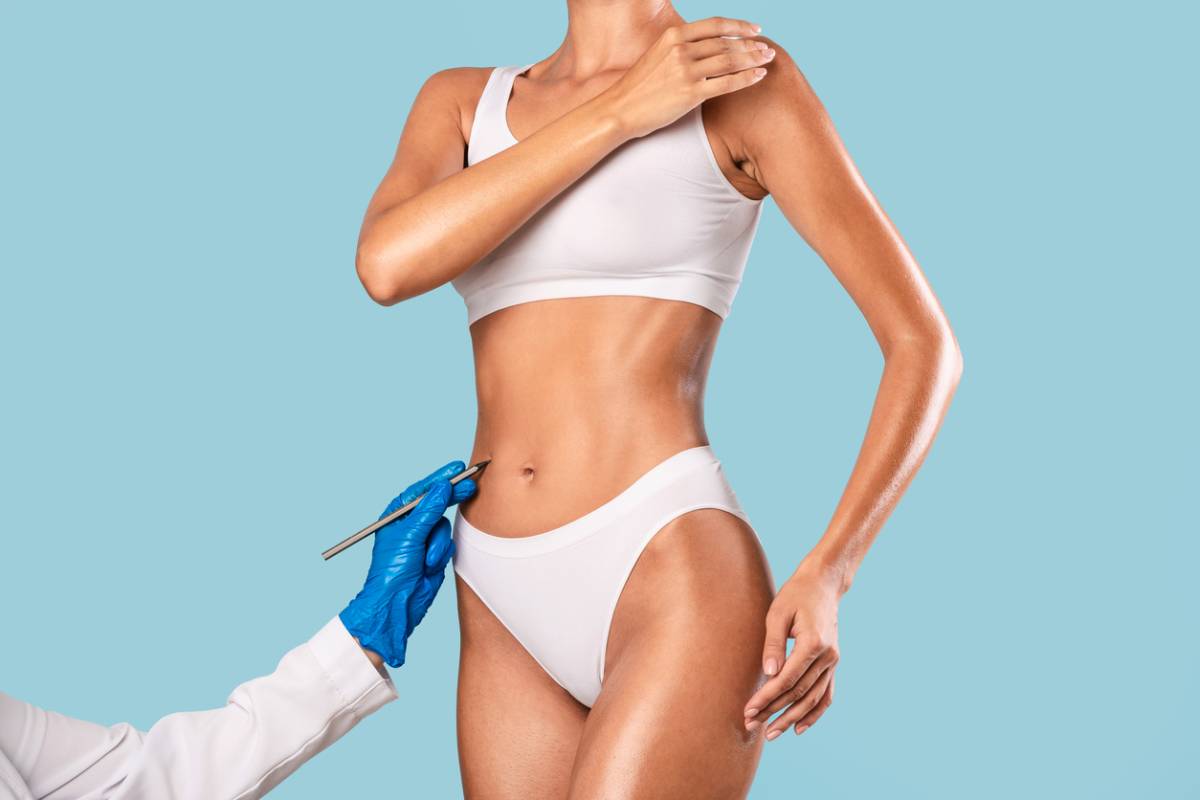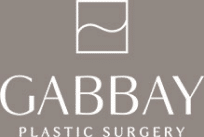Below we examine liposuction vs. non-invasive fat reduction treatments to see which is right for you.
At Gabbay Plastic Surgery, we pride ourselves on providing our patients with not only superior results, but also superior education before you’ve even set foot in our office.
In today’s blog, we outline the difference between these two abdominal procedures, how to know which one you are a candidate for, and other key considerations.
The Types of Fat Reduction Treatments
Because there are a variety of fat removal and reduction operations available, it’s crucial to understand what each one is–and the differences between them.
The most commonly-offered procedures are as follows:
Liposuction:
Liposuction is a surgical fat removal procedure that was first popularized in the 1980s. During this procedure, a board-certified cosmetic surgeon precisely removes excess fat through a small, hollow tube called a cannula. Suction is applied as the surgeon moves the cannula through the fat deposit, removing excess fat cells and sculpting a slimmer body contour. Due to its precision, this procedure is best used for removing fat in the legs, abdomen, face, arms, and thighs.
SculpSure:
As a non-invasive laser body contouring method, SculpSure targets small pockets of unwanted fat beneath the chin and on the flanks, back, stomach, and thighs. Unlike CoolSculpting, which generally only produces temporary results, studies have shown that SculpSure is effective at removing up to 24% of fat cells in a treated area, making it the most effective non-invasive treatment on this list.
truSculpt by Cutera:
Similar to CoolSculpting, truSculpt is a non-surgical option that targets select amounts of fat cells on the hips, buttocks, thighs, and/or abdomen through controlled radiofrequency technology.
CoolSculpting:
Of import, we do NOT provide nor do we recommend this procedure due to its risk of negative effects. CoolSculpting uses ultra-cold technology (called “cryolipolysis”) to freeze small localized spots of fat on the hips, abdomen, or thighs. This kills the fat cells, which are sometimes flushed from the body during the days immediately post-treatment. However, many patients develop a debilitating side effect called PAH, which is why we do not provide it. Instead, we offer liposuction as a means to help patients who received this procedure elsewhere and help them reclaim their bodies.
Out of all the treatments on this list, liposuction is considered the most effective in regards to both long-term results and the amount of fat that can be removed in a single treatment.
Liposuction vs. Non-Invasive Fat Reduction Treatments: The Differences
There are advantages and disadvantages to both liposuction and non-surgical body contouring. The main contrasts are:
Invasiveness: Due to liposuction being a more “aggressive” method of fat reduction, patients commonly experience soreness, bruising, and swelling for up to 10 days post-operation. Non-invasive options, on the other hand, offer both more minimal results and more minimal postoperative discomfort.
Results: Speaking of fat removal treatment results, liposuction results are visible as soon as the swelling goes down in treated areas. Remnants of swelling may take up to six months to resolve. Non-invasive options do not offer the same skin shrinkage and can take up to a year for full results to be seen.
Downtime: During the healing process after liposuction, it is recommended that patients restrict everyday activities (like exercising, lifting heavy objects, or bending down) for several days after the procedure. Non-invasive treatments do not require this same amount of care during recovery.
Side Effects and Potential Risks of Fat Removal
Whether you opt for liposuction or other fat removal treatments, there are always side effects and potential risks to be cognizant of.
Possible complications specific to liposuction include:
- Contour Irregularities: Your skin may appear bumpy due to uneven fat removal, poor skin elasticity, and uneven healing. These changes are, in rare cases, permanent.
- Fluid Accumulation: Temporary pockets of fluid can form under the skin. This fluid may need to be drained with a needle.
- Numbness: You may feel temporary or permanent numbness in the affected area. Temporary nerve irritation also is possible.
- Infection: Skin infections are rare but possible. A severe skin infection may be life-threatening.
- Kidney and Heart Concerns: Shifts in fluid levels as fluids are being injected and suctioned out can cause potentially life-threatening kidney, heart, and lung problems.
- Lidocaine Toxicity: Lidocaine is an anesthetic often administered with fluids injected during liposuction to help manage pain. Although generally safe, in rare circumstances, lidocaine toxicity can occur, causing serious heart and central nervous system problems.
As for non-invasive fat removal concerns, possible complications are:
- Paradoxical Adipose Hyperplasia: PAH is the best-known moderate-to-severe potential side effect of CoolSculpting. Over the course of several months following the CoolSculpting treatment, PAH causes new tissue to grow in the shape of the treated area. The new tissue is usually harder than normal fat, and may have an almost rubbery texture; some say it looks like a block of butter under the skin.
- Mild-to-Moderate Pain: In some cases, non-invasive fat removal treatments can trigger chronic mild-to-moderate pain due to damage to the nerves.
- Lack of Results: Non-invasive treatments also run the risk of being ineffective, thereby wasting time and money.
While liposuction does come with more potential side effects due to its higher levels of effectiveness, working with a certified plastic surgeon will work to slim these risks down to almost zero.
How to Know if You Are a Candidate for Liposuction or Non-Invasive Fat Reduction
Liposuction is often an excellent option for reducing larger deposits of excess fat. It can significantly improve your figure in several areas at once, with its tradeoffs being a higher cost and greater risk for health complications than non-invasive techniques.
Non-surgical fat reduction, on the other hand, is likely a better fit if you are already at your ideal weight, have good skin elasticity, and want to target smaller, stubborn trouble spots. However, the results will not be as dramatic and multiple treatments may be necessary.
We do not recommend liposuction for individuals suffering from:
- Diabetes
- Blood clots
- Restricted blood flow
- Fluctuations in weight
- A history of poor wound healing
- Cardiac problems
- Bleeding disorders
- Pulmonary disease
Regardless of which type of treatment you opt for, ideal candidates are those who are within 30% of their target weight, have no life-threatening illnesses or conditions (including the conditions listed above), are non-smokers, and who have realistic fat loss goals. To ensure a safe procedure, you will be required to stop smoking at least two weeks before and after surgery and to stop taking any blood-thinning or anti-inflammatory drugs.
Fat Removal Options at Gabbay Plastic Surgery
Here at Gabbay Plastic Surgery, we are proud to offer both SculpSure and liposuction.
With SculpSure, you’ll be treated to the world’s first FDA-approved non-invasive laser treatment for the elimination of stubborn fat cells in the abdomen and flanks. Its flat, non-suction applicator and efficient hands-free device make for consistent, natural-looking results.
With liposuction, you can finally get rid of large pockets of fat and achieve your aesthetic goals. Often, the only way to address this diet and exercise-resistant fat is through surgery. No matter how fit or healthy you are, fat can seem to linger forever and disrupt body contours, which liposuction expertly targets.
Under the umbrella of liposuction, there are multiple variations we offer our patients:
Traditional Liposuction:
The tried-and-true method of liposuction that works for most candidates. It is highly flexible and can help patients with removing stubborn fat almost anywhere on the body.
Post-Weight Loss Liposuction:
While liposuction is typically for patients who have had some weight loss, the usual procedure might not be ideal for patients who have experienced more significant weight loss. The reason is that there are structural differences in the body after such large amounts of weight loss that require some adaption of the procedure in order to still produce results that patients love. That is why liposuction after massive weight loss focuses not only on eliminating any remaining pockets of fat, but doing so in a weight that minimizes excess skin.
Water-Assisted Liposuction:
This technique uses pulsating jets of water to wash away and remove unwanted, stubborn fat cells. Water-assisted liposuction involves injecting harvested fat cells in other areas of the body to plump up lost volume.
Laser-Assisted Liposuction:
Laser-assisted liposuction is one of the most commonly performed cosmetic surgery procedures in the United States. Dr. Gabbay uses laser energy to heat and soften fat cells, making them easier to remove via liposuction.
Tumescent Liposuction:
Tumescent Liposuction has revolutionized lipo by making it safer and more comfortable for patients. The procedure uses a large amount of tumescent wetting solution that contains a local anesthetic, salt water, and adrenaline to shrink blood vessels and make the surgery go faster and easier.
Ultrasound-Assisted Liposuction:
This process uses ultrasonic energy (sound waves) to break down fat cells before removing them. Dr. Gabbay uses a small probe that emits ultrasonic energy to break down fat cells. This yields smaller incisions, less trauma, and faster healing times for patients.
All options are effective at reducing fat and improving the overall shape of the body.
Ready to Find Out Which Fat Reduction Treatment is Right For You?
Schedule a consultation today for an expert opinion on what type of fat reduction treatment will make your body dreams become a reality. And learn more about liposuction vs. non-invasive fat reduction treatments.




